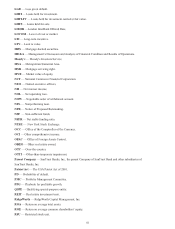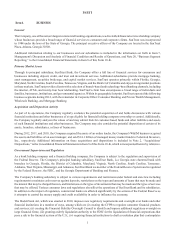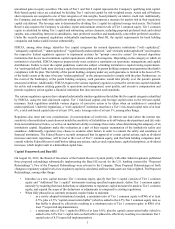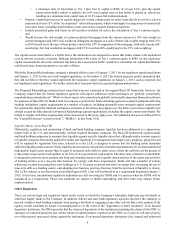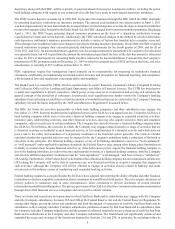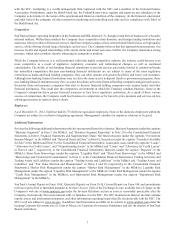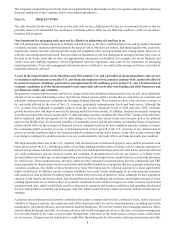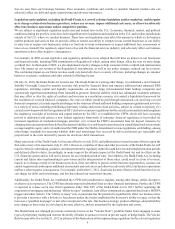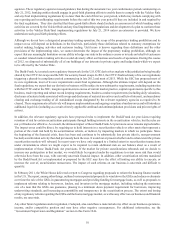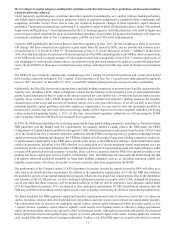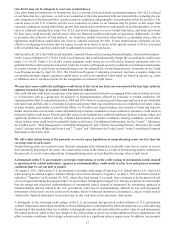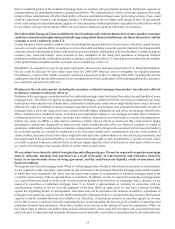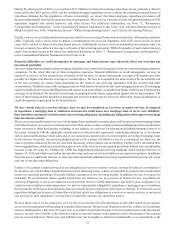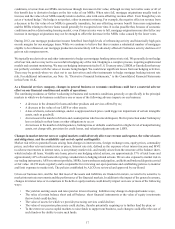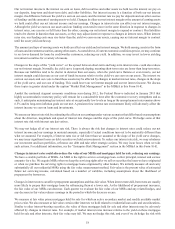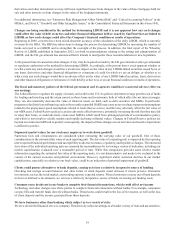SunTrust 2012 Annual Report Download - page 25
Download and view the complete annual report
Please find page 25 of the 2012 SunTrust annual report below. You can navigate through the pages in the report by either clicking on the pages listed below, or by using the keyword search tool below to find specific information within the annual report.9
fees we earn from our brokerage business. Poor economic conditions and volatile or unstable financial markets also can
adversely affect our debt and equity underwriting and advisory businesses.
Legislation and regulation, including the Dodd-Frank Act, as well as future legislation and/or regulation, could require
us to change certain of our business practices, reduce our revenue, impose additional costs on us, or otherwise adversely
affect our business operations and/or competitive position.
We are subject to significant regulation under state and federal laws in the U.S. Economic, financial, market, and political
conditions during the past few years have led to significant new legislation and regulation in the U.S. and in other jurisdictions
outside of the U.S. where we conduct business. These laws and regulations may affect the manner in which we do business
and the products and services that we provide, affect or restrict our ability to compete in our current businesses or our ability
to enter into or acquire new businesses, reduce or limit our revenue in businesses or impose additional fees, assessments or
taxes on us, intensify the regulatory supervision of us and the financial services industry, and adversely affect our business
operations or have other negative consequences.
For example, in 2009 several legislative and regulatory initiatives were adopted that will have an impact on our businesses
and financial results, including FRB amendments to Regulation E which, among other things, affect the way we may charge
overdraft fees. In third quarter 2009, we also implemented policy changes to help customers limit overdraft and returned item
fees. The impact on our revenue of the Regulation E amendments, as well as our policy changes, reduced our fee revenue.
The continuing impact on our future revenue could vary materially due to a variety of factors, including changes in customer
behavior, economic conditions and other potential offsetting factors.
On July 21, 2010, the Dodd-Frank Act became law. The Dodd-Frank Act, among other things, (i) established a new Financial
Stability Oversight Council to monitor systemic risk posed by financial firms and imposes additional and enhanced FRB
regulations, including capital and liquidity requirements, on certain large, interconnected bank holding companies and
systemically significant nonbanking firms intended to promote financial stability which has substantial resolution authority
that may affect or alter the rights of creditors and investors in a resolution scenario; (ii) created a liquidation framework for
the resolution of covered financial companies, the costs of which would be paid through assessments on surviving covered
financial companies; (iii) made significant changes to the structure of bank and bank holding company regulation and activities
in a variety of areas, including prohibiting proprietary trading and private fund activities, subject to certain exceptions; (iv)
created a new framework for the regulation of OTC derivatives and new regulations for the securitization market and strengthens
the regulatory oversight of securities and capital markets by the SEC; (v) established the CFPB, which will have sweeping
powers to administer and enforce a new federal regulatory framework of consumer financial regulation; (vi) provided for
increased regulation of residential mortgage activities; (vii) revised the FDIC's assessment base for deposit insurance by
changing from an assessment base defined by deposit liabilities to a risk-based system based on consolidated total assets minus
average tangible equity; and (vii) authorized the FRB under the Durbin Amendment to issue regulations establishing, among
other things, standards for assessing whether debit card interchange fees received by debit card issuers are reasonable and
proportional to the costs incurred by issuers for electronic debit transactions.
Many provisions of the Dodd-Frank Act became effective in July 2010, and additional provisions became effective upon the
first anniversary of its enactment, July 21, 2011. However, a number of these and other provisions of the Dodd-Frank Act still
require extensive rulemaking, guidance, and interpretation by regulatory authorities and have extended implementation periods
and delayed effective dates. Accordingly, in many respects the ultimate impact of the Dodd-Frank Act and its effects on the
U.S. financial system and us will not be known for an extended period of time. Nevertheless, the Dodd-Frank Act, including
current and future rules implementing its provisions and the interpretation of those rules, could result in a loss of revenue,
require us to change certain of our business practices, limit our ability to pursue certain business opportunities, increase our
capital requirements and impose additional assessments and costs on us and otherwise adversely affect our business operations
and have other negative consequences. For example, on October 1, 2011, final rules became effective which limit the fees we
can charge for debit card interchange, and this has reduced our noninterest income.
Additionally, the Dodd-Frank Act established the CFPB with jurisdiction to regulate, among other things, unfair, deceptive,
or abusive acts or practices. The CFPB has already imposed substantial fines on other financial institutions. Further, the CFPB
is expected to release seven new final regulations under Title XIV of the Dodd-Frank Act in 2013 further regulating the
origination of mortgages and addressing "ability to repay" standards, loan officer compensation, appraisal disclosures, HOEPA
triggers and other matters. The "ability to repay" rule, in particular has the potential to significantly affect our business since
it provides a borrower with a defense to foreclosure unless the lender established the borrower's ability to repay, or that the
loan was a "qualified mortgage" or met other exceptions to the rule. Our business strategy, product offerings, and profitability
may change as these rules are developed, become effective, and are interpreted by the regulators and courts.
The Dodd-Frank Act (through provisions commonly known as the “Volcker Rule”) prohibits banks from engaging in some
types of proprietary trading and restricts the ability of banks to sponsor or invest in private equity or hedge funds. The Volcker
Rule became effective on July 21, 2012 in advance of the finalization of the implementing regulations by the relevant regulatory


